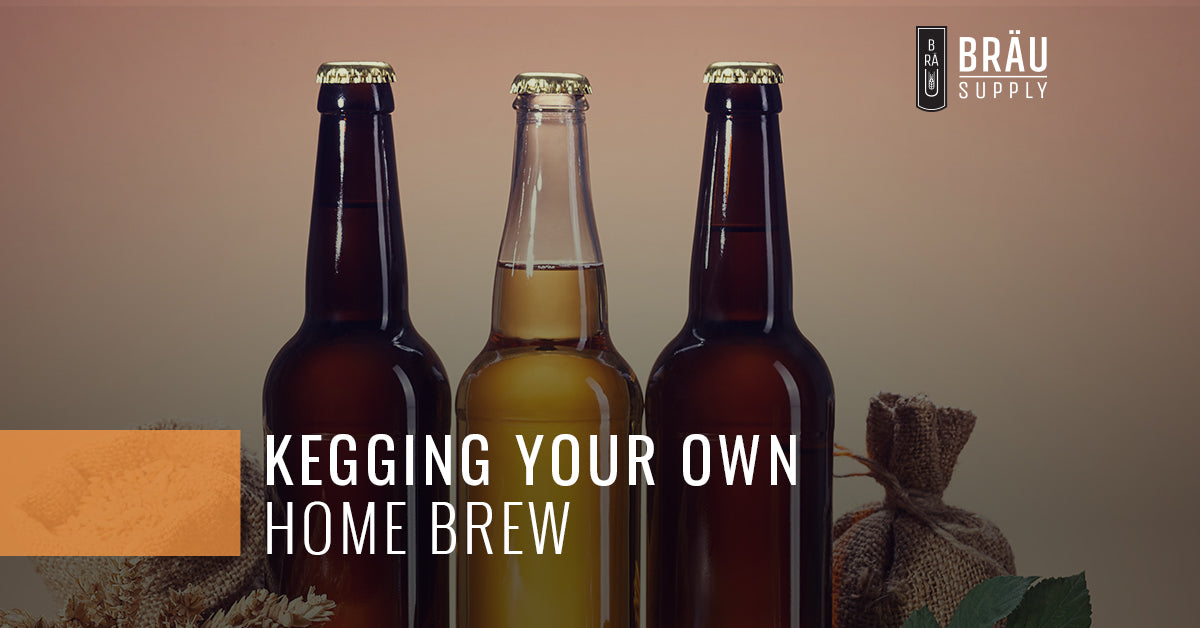Boxing weekend sale! Save up to $700! Shop now Our products ship tariff free

Kegging Your Own Home Brew
March 21, 2018 3 min read

If you’ve been brewing your own beer at home for a while, you’re likely tired of constantly recycling, cleaning, and sanitizing your beer bottles. It can be a little tedious after a while. If you’re looking for a new way to store your beer, it might be time to look into kegging your homebrew. Kegging your homebrew is a great way to keep an entire batch of beer in one vessel, and having it tapped into a kegerator system ensures that you get a fresh beer with every pour.
When you’re ready to step up your brewing, check out the homebrew systems from Bräu Supply. Our all-in-one systems make home brewing more efficient and more fun. Read on to learn more about kegging your own beer.
Getting Started
The biggest barrier to kegging your own beer is cost. Setups, including a keg, CO2 tank, regulator, and hoses will cost about $200. You’ll also need a fridge big enough to store your keg. But these costs are worth it to pour your own beer out of a tap.
Many homebrewers use a Cornelius, or “Corney,” keg for their homebrew, which uses either a ball lock or a pin lock systems. Each lock system requires its own connection types for hoses, so it’s good to be consistent in which style you use.
You’ll want to clean your new keg with a gentle homebrew-specific cleaner, whatever you already use to clean your carboys or fermenting buckets will do fine. Once it’s cleaned out, fill it with sanitizer, and hook it up to your CO2 tank, and run some sanitizer through the lines of the keg for a few minutes to sanitize the entire system.
Kegging Your Beer
Once your keg is nice and clean, it’s time to fill it with delicious home brew beer! This will feel familiar to bottling at first but changes pretty quickly. Use your siphon to transfer the beer from the fermenter into the keg. Minimize the amount of splashing and spilling of the beer as it moves from one vessel to the other so it doesn’t aerate unnecessarily. Unlike bottling, there is no need for charging sugar, as the CO2 tank will carbonate your beer.
After the beer has filled the keg, close up the lid to the keg. After this, you’ll want to hook up your CO2 tank and regulator to the keg. Open the CO2 lines, and turn the regular up to about 10 psi for 20 seconds and then pull the release valve. This process should be repeated two to three times to remove all of the oxygen in the top of the keg. This will help keep your homebrew fresher for longer.
Once the keg is sealed up, and oxygen fee, move the keg to your fridge and keep it at a constant temperature of about 40 degrees Fahrenheit. Turn the regulator to 11 psi, and let the keg sit for two weeks. This will give your homebrew beer time to fully carbonate. When you’re ready to have your first pint out of your keg, your regulator is already set to the perfect pouring pressure!
If your beer isn’t pouring easily or is creating too much foam in your glass, you may need to experiment with the CO2 pressure regulator. Some systems are consistent between batches of beer, and between kegs. Others might need to be adjusted for each particular keg to ensure that you have a perfect pour every time.
Bräu Supply
Here at Bräu Supply, we’re always looking for new ways to make the beer brewing experience easier and more engaging. Our homebrew systems are an all-in-one system, meaning you can contain the entire brewing process in one vessel. It makes your brewing day shorter, and more precise. It’s the best way to brew at home with all grain recipes. Browse our products to learn more!
More articles how to brew beer
The ultimate guide to Kveik yeast: Unleashing it's fermentation potential
Revolutionizing home brewing: The simplified art of no sparge brewing
Exploring amber ales: A guide with a twist on the traditional recipe
Mastering cold crashing: Enhancing beer clarity and accelerating the aging process
What is the basic function of the fermenter?
What causes a fermenter to heat up?
The art of lagering: A guide to perfecting the cold conditioning process
Troubleshooting fermentation problems in brewing: A comprehensive guide
Subscribe
Sign up to get the latest on sales, new releases and more …


